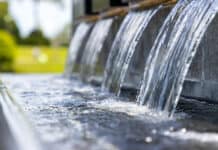In Fall 2017, the U.S. Environmental Protection Agency (EPA) introduced Water Score for multi-family housing properties. Consistent with the approach to the 1-100 ENERGY STAR score, facility management can generate an EPA 1-100 water score to gauge how their multifamily property’s water consumption measures up against similar properties nationwide. This can help to identify potential opportunities for water conservation.

Available to existing multifamily properties with 20 or more units, the score provides a statistical evaluation of whole property water use — including both indoor and outdoor use — normalized for weather and operation. The score was developed using data from the Fannie Mae Energy and Water Market Research Survey.
EPA’s WaterSense program worked with ENERGY STAR to develop the EPA Water Score for multifamily housing. The tool allows building owners and managers to assess water performance and complements the ENERGY STAR score for multifamily housing energy use. A series of Water Efficiency Management Guides was developed to help multifamily housing property owners and managers; however, many of the best practices in the guides can be used by facility managers interested in water conservation for non-residential properties.
For instance, the Bathroom Resource Guide includes: Maintenance Best Management Practices, Retrofit and Replacement Options, Water Savings Calculations and Assumptions, and more. That document and three others (Residential Kitchen and Laundry Guide; Landscaping and Irrigation Guide; and Mechanical Systems Guide) are available as a free download in PDF form from the EPA WaterSense website.
The introduction of the Bathroom Resource Guide provides an overview of the information contained in the document:
“Bathrooms offer a clear opportunity for properties to save significant amounts of water. Use of toilets, faucets, showerheads, and other sanitary fixtures in the bathroom suite typically represent a significant percentage of water use in properties. Beyond user behavior (i.e. how frequently and for what duration products are used), the inherent efficiency of plumbing fixtures and how the products wear over time also impact bathroom water consumption. You can influence tenant water and sewer needs and costs by using sound maintenance practices in addition to opting for water efficient products during renovations. Replacing bathroom fixtures with water-efficient products — and WaterSense labeled products when applicable—can provide the most significant opportunity for water and energy savings, particularly in older buildings with inefficient fixtures.
The first step to identifying potential water savings is to verify the flow rates and flush volumes of each fixture in your units’ bathrooms. Older products have the most room for improvement—not only do they typically use more water than newer products, but maintenance issues are also magnified. By replacing older fixtures with newer, WaterSense labeled models, you’ll save on both water bills and maintenance, all while delivering a more consistent product for your residents.
The Energy Policy Act (EPAct) of 1992 sets the maximum flow rates and flush volumes for many bathroom fixtures, so the date of installation usually corresponds with a particular level of water efficiency. For example, toilets installed after 1994 will have a flush volume of 1.6 gallons per flush (gpf) or less. However, due to the long, useful life of toilets, many older toilets still in use today have flush volumes of 3.5 gpf and up to 5.0 gpf.
The U.S. Environmental Protection Agency’s (EPA’s) WaterSense® program labels certain bathroom fixtures that are at least 20 percent more water-efficient than standard plumbing products on the market (as established by EPAct 1992). WaterSense labeled products are also independently certified to perform as well or better than standard models.”




















![[VIDEO] Collect Asset Data at the Speed of Walking a Building](https://facilityexecutive.com/wp-content/uploads/2024/02/maxresdefault-324x160.jpg)